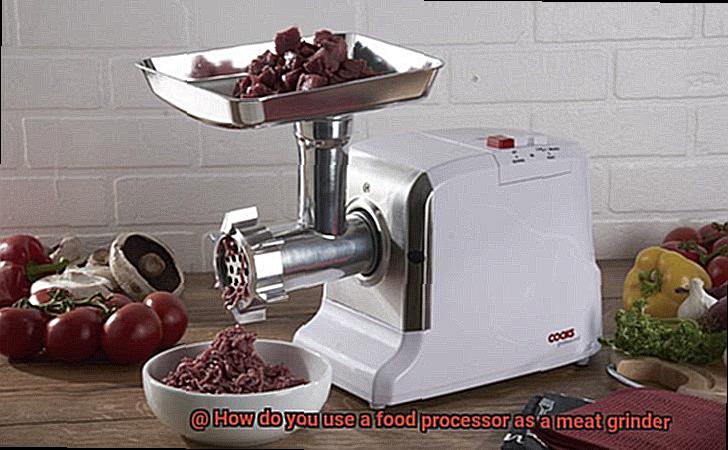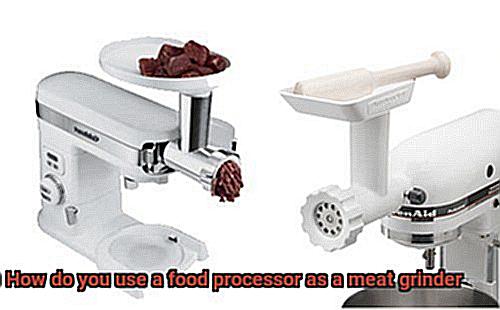Are you a meat lover who’s tired of buying pre-packaged ground meat from the grocery store? Do you want to take control of your meat’s texture, fat content, and flavor? If so, you don’t need to spend a fortune on a fancy meat grinder. Instead, all you need is your trusty food processor.
That’s right – your food processor can double as a meat grinder. Not only is it a practical solution for grinding meat at home, but it’s also a great money saver.

In this post, we’ll guide you through the steps of using your food processor as a meat grinder. From selecting the perfect cut of meat to avoiding over-processing, we’ve got all the tips and tricks you need to achieve that perfect grind. So whether you’re making homemade burgers, sausages or meatloaf, we’ve got you covered.
With our help, you’ll be able to save money, enhance your cooking skills and create delicious ground meat from scratch in no time. So let’s get started.
Contents [show]
What is a Food Processor?
Look no further than a food processor. With its motorized base and sharp blade attached to the center of the bowl, a food processor can tackle these tasks and more.
The beauty of a food processor lies in its versatility. It comes in various sizes and capacities, with different types of blades and attachments for specific purposes. Need to shred cheese or vegetables? Grab the shredding disc. Kneading bread dough? The dough blade has got you covered.
But did you know that you can also use a food processor to grind meat? This feature alone can save you time and money in the kitchen, especially when cooking for a large group of people or making sausage.
To ensure success when grinding meat with a food processor, it’s important to select the right blade and prepare the meat properly. A sharp blade made from high-quality stainless steel is crucial. And don’t forget to chill your meat before processing it – this helps prevent it from becoming too soft and losing its texture.
Once your meat is ready, cut it into small cubes and add it to the food processor. Begin processing on low speed and gradually increase until the meat is finely ground. Be careful not to over-process the meat, as this can make it too soft and mushy.
If you’re feeling adventurous, you can even add spices, herbs, or breadcrumbs to the mixture for added flavor and texture. Mix everything thoroughly before stuffing sausage casings.
What is a Meat Grinder?
It’s a kitchen appliance that can be used to mince or chop meat into small pieces. Meat grinders come in different sizes and shapes, and they can be manual or electric. The basic components of a meat grinder include a hopper, a screw conveyor, and a blade. You simply put the meat into the hopper, and the screw conveyor pushes it towards the blade, which cuts it into small, uniform pieces.
But that’s not all. Many meat grinders come with additional attachments that can be used for other tasks such as shredding cheese or grinding nuts. You can also choose between stainless steel or plastic models. Stainless steel is more durable and easier to clean, while plastic is lighter and more affordable.
One of the biggest advantages of using a meat grinder is that you can make your own ground meat at home. This is not only more affordable than buying pre-packaged ground meat, but it’s also healthier and tastier. You have complete control over the quality of the meat you use, so you can ensure that it’s fresh and free from additives or preservatives. Plus, you can add your own flavorings such as herbs, spices or breadcrumbs to really elevate your dish.
Here are some other benefits of using a meat grinder:
- You can customize the texture of your ground meat based on your recipe
- You can avoid buying pre-packaged ground meat that may contain fillers or additives
- You can save money by purchasing larger cuts of meat and grinding them yourself
- You can experiment with different types of meats such as pork, chicken, turkey, or even game meats like venison or elk
Advantages of Using a Food Processor as a Meat Grinder
First off, food processors are much more versatile than dedicated meat grinders. You can grind meat, vegetables, nuts, and other ingredients all in one machine, saving you time and counter space. With a food processor at hand, you can easily create homemade burgers, sausages, and meatballs with fresh ingredients that you trust.
But the advantages don’t stop there. Using a food processor as a meat grinder is more budget-friendly than buying a separate meat grinder. Food processors are often less expensive than dedicated meat grinders, making them an affordable option for those who want to grind their own meat at home. Plus, you can save money by purchasing larger cuts of meat and grinding them yourself instead of buying pre-ground meat.
Cleaning up after grinding your own meat can be a daunting task, but with a food processor, it’s a breeze. Food processors have fewer parts than meat grinders and can be easily disassembled for quick and easy cleaning. You won’t have to worry about time-consuming cleaning processes or hard-to-reach areas.
Finally, using a food processor as a meat grinder gives you greater control over the texture of your ground meat. You can choose how finely or coarsely you want your meat ground, allowing you to customize your recipes to your personal preferences. Whether you prefer chunky ground beef for your chili or fine ground pork for your dumplings, a food processor can do it all.
Selecting the Right Blade for Your Food Processor
First things first – there are two blades that come with most food processors: the S-shaped blade and the shredding disc. While the shredding disc is great for shredding cheese or vegetables, the S-shaped blade is your go-to for grinding meat. But not all blades are created equal. The sharpness, size, and material of the blade can all affect the quality of your ground meat.
Sharpness is paramount when it comes to grinding meat. Dull blades not only produce poor quality meat but also damage your food processor. Opt for a blade with sharp edges that can slice through meat effortlessly. Size also plays a role – a smaller blade will give you a finer grind, while a larger one will produce a coarser texture.
In terms of material, stainless steel blades are the gold standard. They’re durable, easy to clean, and can withstand high temperatures. However, if you have a plastic blade, ensure it’s made from high-quality plastic that won’t warp or deform over time.

Lastly, some food processors come with attachments specifically designed for grinding meat. These attachments include specially designed grinding plates that make it simple to achieve your desired texture. They’re durable and dishwasher safe, saving you time and energy in the long run.
Preparing the Meat for Processing
Look no further than your trusty food processor. But before you start, let’s discuss how to properly prepare the meat for processing.
First things first, selecting the right cut of meat is crucial. Opt for cuts with a good amount of fat and connective tissue, like chuck, sirloin, or brisket. These cuts will not only provide flavor but also texture to your ground meat.
Once you’ve got your cut of choice, it’s time to cut it into small, uniform pieces that will easily fit into your food processor. This step is essential as unevenly sized pieces won’t grind evenly. You can use a sharp knife or a meat cleaver, but take your time to ensure consistency.
Before grinding, it’s best to chill the meat in the refrigerator for at least 30 minutes. This will prevent the fat from melting and getting too soft, which can make grinding difficult.
Removing any large pieces of fat or connective tissue that won’t grind well is also recommended. By doing so, you’ll achieve a smoother and more consistent texture in your ground meat.
Lastly, cleanliness is key. Make sure to thoroughly wash your food processor and any utensils or surfaces that come into contact with the meat before and after use. Using hot soapy water will help prevent contamination and keep your ground meat safe to eat.
Processing the Meat in the Food Processor
Before you start processing, it’s crucial to follow proper steps and precautions for safe and effective grinding.
Step 1: Cut Your Meat into Small Pieces
Begin by cutting your meat into smaller pieces that can easily fit into the food processor. If you’re having difficulty grinding, try partially freezing the meat for 20-30 minutes to make it easier.
Step 2: Attach the Grinding Blade
Attach the grinding blade to your food processor and carefully place the meat inside. Avoid overfilling the processor as this can cause uneven grinding.
Step 3: Pulse the Meat
Turn on the food processor and pulse the meat in short bursts until it reaches your desired consistency. Avoid continuously running the processor as this can overwork the meat, resulting in an overly fine texture.
Step 4: Clean Your Food Processor
Once you’re done grinding, thoroughly clean your food processor with soap and water to prevent cross-contamination. Handle the ground meat with care and keep it refrigerated until ready to use.
Adding Spices or Herbs to the Mixture (For Sausage)
Adding spices and herbs is the key to unlocking an explosion of flavor in every bite. As a seasoned expert, I can guide you through the process of incorporating these essential ingredients into your sausage mixture.
Firstly, it’s crucial to select the right spices and herbs for your recipe. Paprika adds a smoky sweetness that complements the meat perfectly, while garlic powder, onion powder, fennel seeds, and black pepper add depth and complexity to the flavor profile. As for herbs, sage’s slightly peppery taste is a classic choice that pairs well with meat. Alternatively, rosemary, thyme, and oregano offer a more herbaceous note that can also be used depending on personal taste preferences.
Once you’ve chosen your spices and herbs, it’s time to add them to your sausage mixture. Uniform distribution is key to achieving consistent flavor in every bite. You can either mix them together in a small bowl before adding them to the meat or sprinkle them directly onto the meat and mix thoroughly.
It’s important to note that some spices like salt and cayenne pepper can affect the texture of the sausage if added in excess. So be mindful of how much you’re adding.
To ensure optimal results, thoroughly clean your equipment before and after use to avoid any unwanted contamination. With these steps in mind, experiment with different spice and herb combinations until you find your perfect blend.
Stuffing the Sausage Casings
Using a food processor as a meat grinder to stuff sausage casings can be a fun and rewarding experience. But before you start, there are a few things to keep in mind.
First, make sure you have the appropriate attachments for your food processor. A grinding attachment will be needed to grind the meat, while a stuffing tube attachment will be necessary to stuff the casings. Once you have everything ready, it’s time to prepare your meat mixture.
Mix together your choice of meats, like pork, beef, or chicken, with your preferred seasonings. This is where you can get creative and add flavors like garlic, paprika, and fennel to make your sausages uniquely yours.
Now it’s time to stuff the casings. Attach the stuffing tube onto your food processor and slide the casing over the end of the tube. Slowly feed the meat mixture into the food processor while guiding the casing onto the tube. Be careful not to overstuff the casing or it may break.
Here are some tips on how to make sure you get it right:
- Use chilled meat to make it easier to grind and stuff
- Keep an eye on the casing as it fills up with meat to prevent breaking
- Twist the sausage links once they are stuffed for easier handling
Once you’ve stuffed all of your casings, it’s time to cook them up. You can grill them over an open flame or cook them in a pan on the stove. Just be sure to cook them thoroughly until they reach an internal temperature of 160 degrees Fahrenheit to ensure they are safe to eat.
ycvBWb894xE” >
Conclusion
To sum it up, using a food processor as a meat grinder is a smart and affordable way to grind meat at home. With the appropriate blade and preparation, you can achieve the ideal texture and flavor in your ground meat, be it for burgers, sausages or meatloaf. Additionally, opting for a food processor over a dedicated meat grinder provides versatility, affordability, and easy cleaning.
When selecting the right blade for your food processor, keep in mind that sharpness, size, and material all play an essential role. Properly preparing the meat by choosing the right cut and chilling it before processing is also vital to ensure consistent results.
By using a food processor as a meat grinder, you can tailor your recipes to suit your taste buds by adding spices or herbs to your sausage mixture or stuffing casings with your ground meat mixture.






